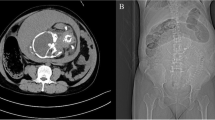Abstract
Two cases of intestinal atresia due to in utero intussusception are reported. Meconium peritonitis occurred in both cases and in one free air in the peritoneal cavity was also found. Both were managed successfully by resection and end-to-end anastomosis. The intussusceptions were discovered on gross and microscopic examination of the distal ileal segment. These two cases and 33 from the literature are reviewed to determine major features of this seemingly unusual occurrence. The atresia was limited to the ileum and jejunum in all cases and involved the ileum in 77%. The atresia was limited to the gap and fibrous-connecting-cord types in all cases, with the gap type slightly more frequent (57%). In all but 1 of the 35 cases (97%), the intussusceptum was found in the small-bowel segment distal to the atresia; in only 2 were free air and calcium deposits identified at birth on X-ray studies of the abdomen. Prematurity was encountered in only 14% of the 35 cases, suggesting that intussusceptum-induced midgut atresia occurs late in pregnancy. The occurrence of two cases in 2 years in Torrance, California, and three cases in 3 years in Helsinki, Finland, suggest that this occurrence must be more frequent than the sparse incidence reported in the literature would indicate. It is suggested that careful gross and microscopic examination of the small-bowel segment just distal to the atresia be carried out in all cases of jejunoileal atresia of gap or cord types to determine the true incidence and clinical nature of this type of in utero intussusception-induced jejunoileal atresia.
Similar content being viewed by others
References
Adejuyigbe D, Odesanmi WD (1990) Intrauterine intussusception causing intestinal atresia. J Pediatr Surg 25: 562–563
Evans CH (1971) Atresias of the gastrointestinal tract. Surg Gynecol Obstet Int Abstr Surg 92: 1–8
Gheradi GJ, Fisher JH (1961) Atresia of the small intestine produced by intussusception in utero. N Engl J Med 264: 229–231
Grosfeld JL, Clatworthy HW (1970) The nature of ileal atresia due to intrauterine intussusception. Arch Surg 100: 714–717
Lannin BG, Leven NL, Tongen LA (1955) Congenital obstruction of the small intestine and colon. Arch Surg 70: 808–817
Louw JH, Barnard CN (1955) Congenital intestinal atresia: observation on its origin. Lancet 2: 1065–1067
McMullin N, Beasley SW, Kelly JH (1987) Prenatal intussusception of a vitellointestinal duct in association with ileal atresia. Pediatr Surg Int 2: 122–123
Moore TC, Shumacker HB (1952) Intussusception of ileum through persistent omphalomesenteric duct: review of the literature and report of two cases. Surgery 31: 278–284
Nixon HH, Tawes R (1971) Etiology and treatment of small intestinal atresia: analysis of a series of 127 jejunoileal atresia and comparision with 62 duodenal atresias. Surgery 69: 41–51
Parkkulainen KV (1958) Intrauterine intussusception as a cause of intestinal atresia: a contribution to the etiology of intestinal atresia. Surgery 44: 1106–1111
Parri DR, Marshall DG, Armstrong RF, Gorodzinski FP (1983) Intrauterine intussusception: case report and review of literature. Can J Surg 26: 376–378
Rachelson MH, Jernigan JP, Jackson WF (1955) Intussusception in the newborn infant: with spontaneous expulsion of the intussusceptum; a case report and review of the literature. J Pediatr 47: 87–94
Senocak ME, Buyupamukcu N, Hicsonmez A (1990) Ileal atresia due to intrauterine intussusception caused by Meckel's diverticulum. Pediatr Surg Int 5: 64–66
Shnitka TK, Sherbaniuk RW (1956) Congenital intussusception complicated by meconium peritonitis: report of a case. Obstet Gynecol 7: 293–298
Spencer R (1968) The various patterns of intestinal atresia. Surgery 64: 661–668
Srikanth MS, Wong RS, Applebaum H, Wolley MM, Mahour GH (1992) Clinicopathologic spectrum and management of neonatal intussusception. Pediatr Surg Int 7: 218–220
Todani T, Tabuchi K, Tanaka S (1955) Intestinal atresia due to intrauterine intussusception: analysis of 24 cases in Japan. J Pediatr Surg 10: 445–451
Tsujimoto K, et al. (1972) Experimental intestinal atresia in rabbit fetus: sequential pathological studies. Med J 131: 287
Author information
Authors and Affiliations
Rights and permissions
About this article
Cite this article
Nguyen, D.T., Lai, E., Cunningham, T. et al. In utero intussusception producing ileal atresia and meconium peritonitis with and without free air. Pediatr Surg Int 10, 406–408 (1995). https://doi.org/10.1007/BF00182241
Accepted:
Issue Date:
DOI: https://doi.org/10.1007/BF00182241




